

STONES SOUND STUDIO
 |
 |
Application note for Peerless XLS 10" and XLS 12" subwoofer drivers for cars Introduction: The following is an application note of how to use the Peerless XLS family of subwoofer drive units especially designed for cars. The application note is meant as a starting point and as inspiration for the designer who wishes to build a subwoofer using a Peerless XLS driver. The drivers mentioned in this document are distribution drivers as Peerless has a broad range of specially developed OEM products to suit special requirements. Peerless XLS subwoofer family: The Peerless XLS family consists of a range of drivers especially developed for the high performance subwoofer application. The goal with the design has been to produce drivers with an unexcelled long excursion performance with low distortion. Using Strontium Ferrite Magnets and Finite Element Analysis to optimise the iron circuit, high levels of BL have been obtained. With the high BL available, Peerless has been able to design drivers with a high moving mass and low fs but without high Qt and low sensitivity. Mechanically the subwoofers offer a strong base, which will provide many years of high performance bass reproduction. The aerodynamic cast aluminium frame supports the vented Nomex spider and rubber surround for a heavy-duty suspension that will not fatigue. The rigid fibre reinforced and deep impregnated cone will produce low distortion bass without coloration. Design goals: This application note will describe two different approaches to design a subwoofer with the following specifications: · Compact design sealed box for both the 10" and the 12" XLS drivers. · Vented box for both the 10" and the 12" XLS drivers. Sealed box design for Peerless 10" XLS driver 830514: Using this driver in a 14 liter sealed box will give the response below, when the car environment is taken in to account.  It can be seen that low bass extension is possible in a small sealed box. With a 300 W amplifier max output from the system is:  This simulation says that around 60 Hz the sound pressure in 1 meter distance is approximately 110 dB from a 14 liter box. Vented box design for Peerless 10" XLS driver 830514: Peerless XLS drivers have been developed especially for sealed enclosures. Therefore it is at the users own risk to use the drivers in a vented box. The vented box has no control over the cone movement below a certain frequency, which is the tuning frequency of the box. Therefore it is possible to overload the driver resulting in voice coil damage. Using the XLS drivers in vented boxes is therefore at your own risk. However very good results can be obtained in the vented system and therefore we have posted this design approach also. Below is a simulation using 830514 in a 20 liter vented box. Box tuning is: Fb = 60 Hz Port diameter 15 cm Port length 61 cm The port should have flares at both ends to minimize port noise. 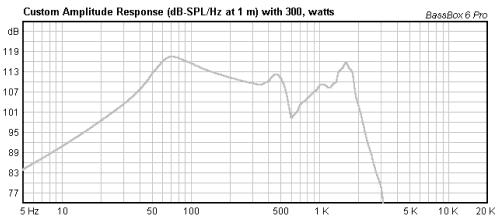 From the simulation can be seen that very high SPL above 116 dB is possible from 60 to 100 Hz. However the cone displacement is also very high below tuning, see graph below for peak displacement. 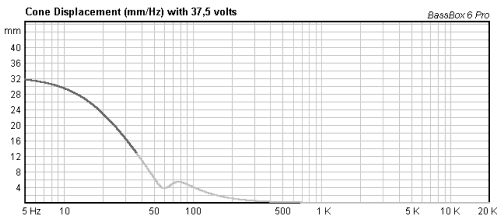 At 20 Hz the cone displacement is at maximum allowable resulting in risk of damage to the driver. If the amplifier has a subsonic filter this should be set for 30 Hz High Pass protecting the driver from overload. See green curve below. 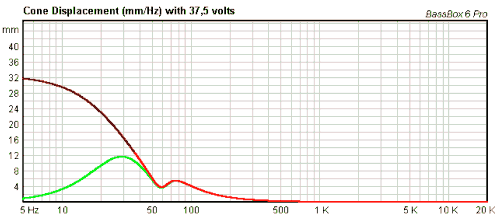 Comparing the above peak displacement curve with the red it can clearly be seen that the high pass filter (green curve) protect the driver from overload because the cone displacement is well below max in the full frequency range. Further bass extension (red curve) can be obtained in a 25 litre box using the same port dimensions as for the 20 liter box. 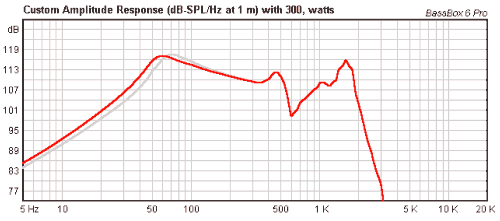 Sealed box design for Peerless 12" XLS driver 830515: Using this driver in a 20 liter sealed box will give the response below, when the car environment is taken in to account. 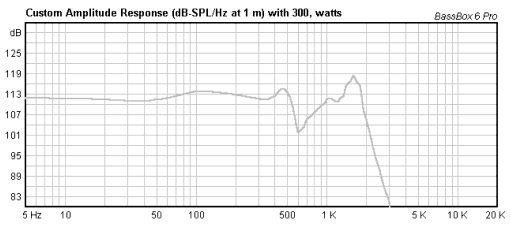 It can be seen that low bass extension is possible in a small sealed box. This simulation says that around 60 Hz the sound pressure in 1 meter distance is approximately 112 dB from a 20 liter box. Vented box design for Peerless 12" XLS driver 830515: Peerless XLS drivers have been developed especially for sealed enclosures. Therefore it is at the users own risk to use the drivers in a vented box. The vented box has no control over the cone movement below a certain frequency, which is the tuning frequency of the box. Therefore it is possible to overload the driver resulting in voicecoil damage. Using the XLS drivers in vented boxes is therefore at your own risk. However very good results can be obtained in the vented system and therefore we have posted this design approach also. Below is a simulation using 830515 in a 28 liter vented box. Box tuning is: Fb = 56 Hz Port diameter 17 cm Port length 61 cm The port should have flares at both ends to minimize port noise. 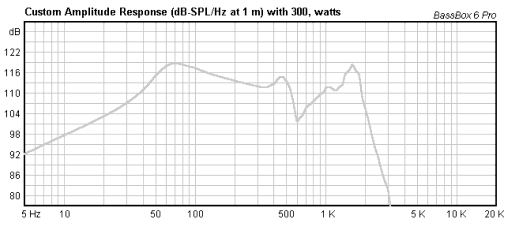 From the simulation can be seen that very high SPL close to 119 dB is possible from 60 to 100 Hz. However the cone displacement is also very high below tuning, see graph below for peak displacement. 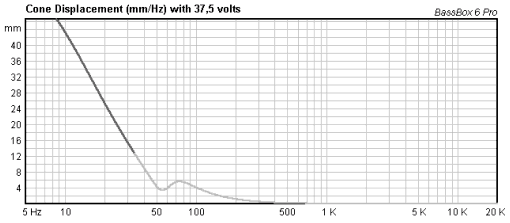 At 20 Hz the peak cone displacement is above maximum allowable resulting in risk of damage to the driver. If the amplifier has a subsonic filter this should be set for around 30 Hz, protecting the driver from overload see graph below green curve. 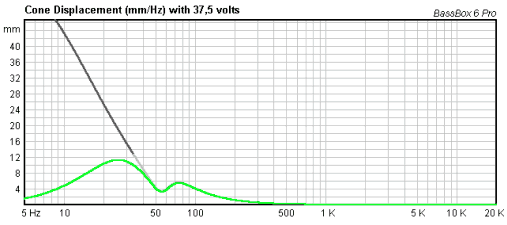 As seen above the high pass filter greatly reduces cone displacement below tuning. Further bass extension (red curve) can be obtained in a 35 litre box using the same port dimensions as for the 28 litre box above. 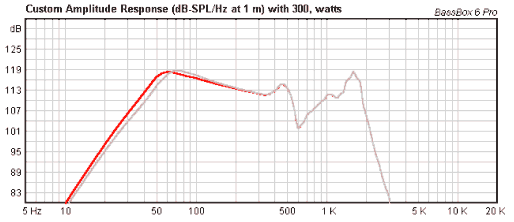 Conclusion and disclaimer: It has been shown that it is possible to achieve high sound pressure levels using the XLS drive units in different configurations. Proper filters and limiters are highly recommended. Filters and limiters is an important but often overlooked detail in high performance subwoofers. The port design in small vented box systems is complicated because the length has to be very long. The information contained herein is provided for the designer to have a starting point for development on high performance subwoofers. We believe the information to be true and reliable, but there are many ways to design subwoofer systems. We cannot assume responsibility for the results obtained by others over whose methods we have no control. |